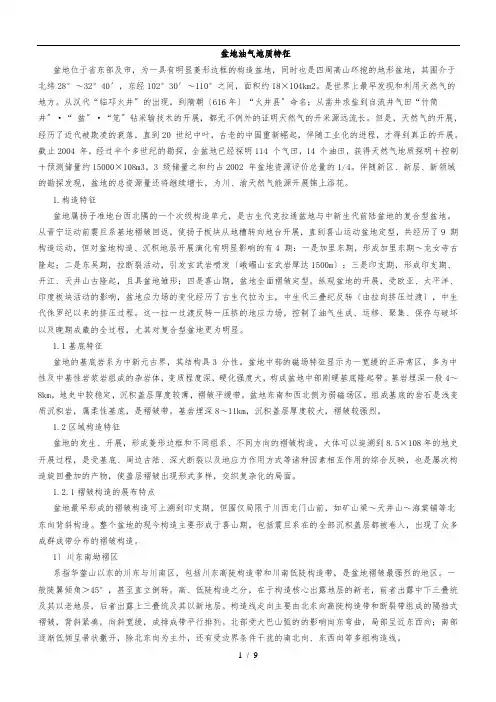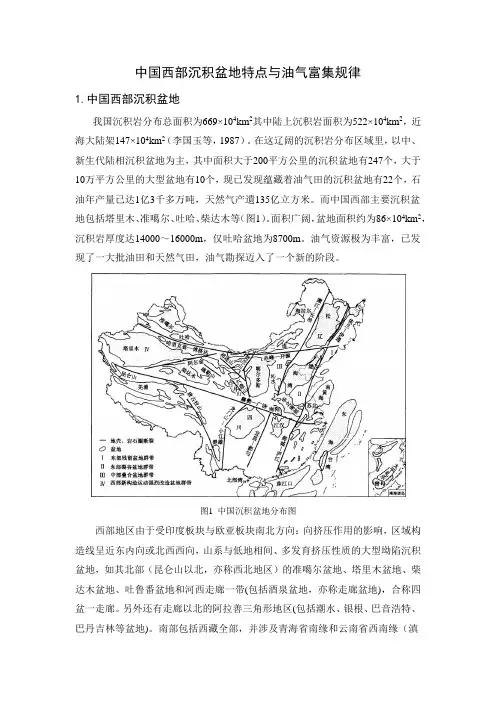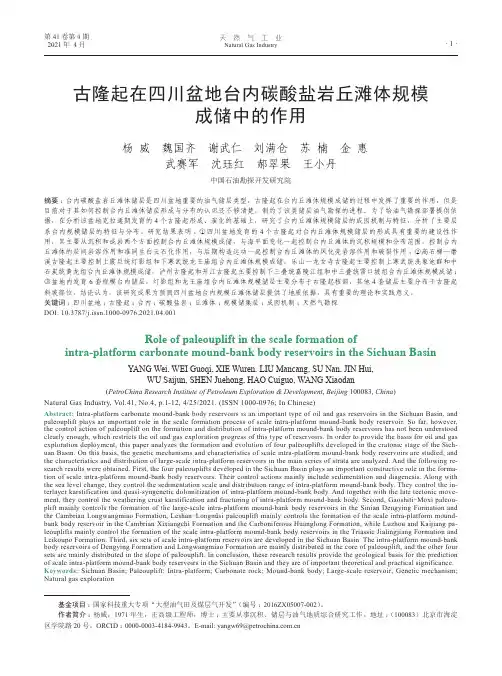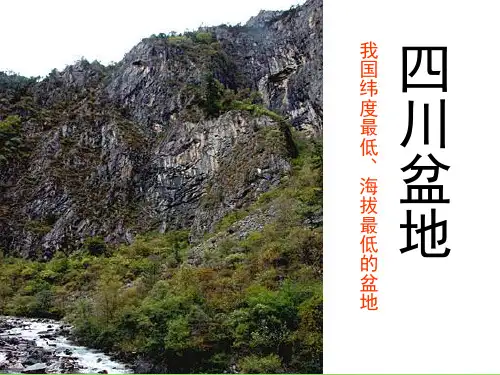四川盆地构造特征与油气(魏国齐等 著)思维导图
- 格式:xmin
- 大小:4.42 KB
- 文档页数:1

盆地油气地质特征盆地位于省东部及市,为一具有明显菱形边框的构造盆地,同时也是四周高山环抱的地形盆地,其围介于北纬28°~32°40′,东经102°30′~110°之间,面积约18×104km2。
是世界上最早发现和利用天然气的地方。
从汉代“临邛火井〞的出现,到隋朝〔616年〕“火井县〞命名;从凿井求盐到自流井气田“竹筒井〞·“盆〞·“笕〞钻采输技术的开展,都无不例外的证明天然气的开采源远流长。
但是,天然气的开展,经历了近代被欺凌的衰落,直到20 世纪中叶,古老的中国重新崛起,伴随工业化的进程,才得到真正的开展。
截止2004 年,经过半个多世纪的勘探,全盆地已经探明114 个气田,14 个油田,获得天然气地质探明+控制+预测储量约15000×108m3,3 级储量之和约占2002 年盆地资源评价总量的1/4。
伴随新区、新层、新领域的勘探发现,盆地的总资源量还将继续增长,为川、渝天然气能源开展锦上添花。
1.构造特征盆地属扬子准地台西北隅的一个次级构造单元,是古生代克拉通盆地与中新生代前陆盆地的复合型盆地。
从晋宁运动前震旦系基地褶皱回返,使扬子板块从地槽转向地台开展,直到喜山运动盆地定型,共经历了9 期构造运动,但对盆地构造、沉积地层开展演化有明显影响的有4 期:一是加里东期,形成加里东期~龙女寺古隆起;二是东吴期,拉断裂活动,引发玄武岩喷发〔峨嵋山玄武岩厚达1500m〕;三是印支期,形成印支期、开江、天井山古隆起,且具盆地雏形;四是喜山期,盆地全面褶皱定型。
纵观盆地的开展,受欧亚、太平洋、印度板块活动的影响,盆地应力场的变化经历了古生代拉为主,中生代三叠纪反转〔由拉向挤压过渡〕,中生代侏罗纪以来的挤压过程。
这一拉-过渡反转-压挤的地应力场,控制了油气生成、运移、聚集、保存与破坏以及晚期成藏的全过程,尤其对复合型盆地更为明显。

中国西部沉积盆地特点与油气富集规律1.中国西部沉积盆地我国沉积岩分布总面积为669×104km2其中陆上沉积岩面积为522×104km2,近海大陆架147×104km2(李国玉等,1987)。
在这辽阔的沉积岩分布区域里,以中、新生代陆相沉积盆地为主,其中面积大于200平方公里的沉积盆地有247个,大于10万平方公里的大型盆地有10个,现已发现蕴藏着油气田的沉积盆地有22个,石油年产量已达1亿3千多万吨,天然气产遺135亿立方米。
而中国西部主要沉积盆地包括塔里木、准噶尔、吐哈、柴达木等(图1)。
面积广阔,盆地面积约为86×104km2,沉积岩厚度达14000~16000m,仅吐哈盆地为8700m。
油气资源极为丰富,已发现了一大批油田和天然气田,油气勘探迈入了一个新的阶段。
图1 中国沉积盆地分布图西部地区由于受印度板块与欧亚板块南北方向:向挤压作用的影响,区域构造线呈近东内向或北西西向,山系与低地相间、多发育挤压性质的大型坳陷沉积盆地,如其北部(昆仑山以北,亦称西北地区)的准噶尔盆地、塔里木盆地、柴达木盆地、吐鲁番盆地和河西走廊一带(包括酒泉盆地,亦称走廊盆地),合称四盆一走廊。
另外还有走廊以北的阿拉善三角形地区(包括潮水、银根、巴音浩特、巴丹吉林等盆地)。
南部包括西藏全部,并涉及青海省南缘和云南省西南缘(滇西)。
这些沉积盆地多属山前或山间的大型坳陷盆地,形成时间旱,经历过分异、叠加等长期演化。
此外,尚有少数山间断陷小盆地,由于这些盆地四周山地上升快、地势高,风化剥蚀快,产生大量粗碎屑风化产物,盆地沉降快但充填也快,常处于补偿或过补偿状态。
另外,许多盆地形成时期节,沉积时间长,故沉积厚度大,粗碎屑物质多,河流相和洪积相很发育,湖泊面积也大,但变化快、湖水较浅,深湖区的比例小。
另一特点是西部地区的地壳厚度大,一般40~50公里,最厚处达70公里,地温悌度低,2~2.60/100米,甚至更低。


天 然 气 工 业Natural Gas Industry第41卷第4期2021年 4月· 1 ·古隆起在四川盆地台内碳酸盐岩丘滩体规模成储中的作用杨 威 魏国齐 谢武仁 刘满仓 苏 楠 金 惠 武赛军 沈珏红 郝翠果 王小丹中国石油勘探开发研究院摘要:台内碳酸盐岩丘滩体储层是四川盆地重要的油气储层类型,古隆起在台内丘滩体规模成储的过程中发挥了重要的作用,但是目前对于其如何控制台内丘滩体储层形成与分布的认识还不够清楚,制约了该类储层油气勘探的进程。
为了给油气勘探部署提供依据,在分析该盆地克拉通期发育的4个古隆起形成、演化的基础上,研究了台内丘滩体规模储层的成因机制与特征,分析了主要层系台内规模储层的特征与分布。
研究结果表明:①四川盆地发育的4个古隆起对台内丘滩体规模储层的形成具有重要的建设性作用,其主要从沉积和成岩两个方面控制台内丘滩体规模成储,与海平面变化一起控制台内丘滩体的沉积规模和分布范围,控制台内丘滩体的层间岩溶作用和准同生白云石化作用,与后期构造运动一起控制台内丘滩体的风化壳岩溶作用和破裂作用;②高石梯—磨溪古隆起主要控制上震旦统灯影组和下寒武统龙王庙组台内丘滩体规模成储,乐山—龙女寺古隆起主要控制上寒武统洗象池群和中石炭统黄龙组台内丘滩体规模成储,泸州古隆起和开江古隆起主要控制下三叠统嘉陵江组和中三叠统雷口坡组台内丘滩体规模成储; ③盆地内发育6套规模台内储层,灯影组和龙王庙组台内丘滩体规模储层主要分布于古隆起核部,其他4套储层主要分布于古隆起斜坡部位。
结论认为,该研究成果为预测四川盆地台内规模丘滩体储层提供了地质依据,具有重要的理论和实践意义。
关键词:四川盆地;古隆起;台内;碳酸盐岩;丘滩体;规模储集层;成因机制;天然气勘探DOI: 10.3787/j.issn.1000-0976.2021.04.001Role of paleouplift in the scale formation ofintra-platform carbonate mound-bank body reservoirs in the Sichuan BasinYANG Wei, WEI Guoqi, XIE Wuren, LIU Mancang, SU Nan, JIN Hui,WU Saijun, SHEN Juehong, HAO Cuiguo, WANG Xiaodan(PetroChina Research Institute of Petroleum Exploration & Development , Beijing 100083, China )Natural Gas Industry, Vol.41, No.4, p.1-12, 4/25/2021. (ISSN 1000-0976; In Chinese)Abstract: Intra-platform carbonate mound-bank body reservoirs is an important type of oil and gas reservoirs in the Sichuan Basin, and paleouplift plays an important role in the scale formation process of scale intra-platform mound-bank body reservoir. So far, however, the control action of paleouplift on the formation and distribution of intra-platform mound-bank body reservoirs has not been understood clearly enough, which restricts the oil and gas exploration progress of this type of reservoirs. In order to provide the basis for oil and gas exploration deployment, this paper analyzes the formation and evolution of four paleouplifts developed in the cratonic stage of the Sich-uan Basin. On this basis, the genetic mechanisms and characteristics of scale intra-platform mound-bank body reservoirs are studied, and the characteristics and distribution of large-scale intra-platform reservoirs in the main series of strata are analyzed. And the following re-search results were obtained. First, the four paleouplifts developed in the Sichuan Basin plays an important constructive role in the forma-tion of scale intra-platform mound-bank body reservoirs. Their control actions mainly include sedimentation and diagenesis. Along with the sea level change, they control the sedimentation scale and distribution range of intra-platform mound-bank body. They control the in-terlayer karstification and quasi-syngenetic dolomitization of intra-platform mound-bank body. And together with the late tectonic move-ment, they control the weathering crust karstification and fracturing of intra-platform mound-bank body. Second, Gaoshiti -Moxi paleou-plift mainly controls the formation of the large-scale intra-platform mound-bank body reservoirs in the Sinian Dengying Formation and the Cambrian Longwangmiao Formation, Leshan -Longnüsi paleouplift mainly controls the formation of the scale intra-platform mound-bank body reservoir in the Cambrian Xixiangchi Formation and the Carboniferous Huanglong Formation, while Luzhou and Kaijiang pa-leouplifts mainly control the formation of the scale intra-platform mound-bank body reservoirs in the Triassic Jialingjiang Formation and Leikoupo Formation. Third, six sets of scale intra-platform reservoirs are developed in the Sichuan Basin. The intra-platform mound-bank body reservoirs of Dengying Formation and Longwangmiao Formation are mainly distributed in the core of paleouplift, and the other four sets are mainly distributed in the slope of paleouplift. In conclusion, these research results provide the geological basis for the prediction of scale intra-platform mound-bank body reservoirs in the Sichuan Basin and they are of important theoretical and practical significance. Keywords: Sichuan Basin; Paleouplift; Intra-platform; Carbonate rock; Mound-bank body; Large-scale reservoir; Genetic mechanism; Natural gas exploration基金项目:国家科技重大专项“大型油气田及煤层气开发”(编号:2016ZX05007-002)。






